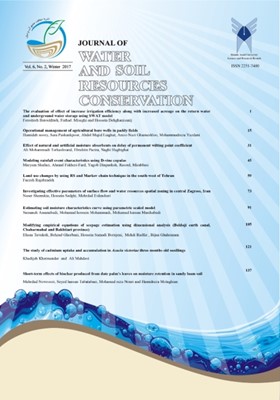Estimating soil moisture characteristics curve using parametric scaled model
Subject Areas : Farm water management with the aim of improving irrigation management indicatorsSamaneh Amanaabadi 1 * , Mohamad hossein Mohamadi 2 , Mohamad hasan Masih abadi 3
1 - دانشگاه آزاد اسلامی واحد علوم تحقیقات تهران دانشکده کشاورزی و منابع طبیعی گروه خاک شناسی;شناسی
2 - گروه خاک شناسی;شناسی دانشگاه زنجان
3 - استادیار پژوهشی؛موسسه تحقیقات خاک و آب
Keywords: soil moisture characteristics curve, parametric model, particle size distribution,
Abstract :
Direct measurement of soil moisture characteristics curve (SMC) due to spatial and temporal variation is labor and expensive. Therefore, estimation of SMC from basic soil properties which can be measured easily would be satisfactory. In this study, a dataset containing 50 particle size distributions (PSD) data of UNSODA were selected to verify parametric and nonparametric (ROSETTA model). Results indicated that SMC is easily predictable by means of PSD curve and parametric models could predict SMC more accurate than ROSETTA software. In order to determine the effect of the number of model input in prediction of SMC two methods were used, full PSD method using at least 4 mass particle frequencies, semi PSD method using sand, silt and clay percentages as a model input. Statistical analysis revealed that semi PSD method is the best fitted model to experimental data. The semi PSD method predicted SMC more accurately in comparison with other methods as a result of data independency. The predicted SMC is continuous and more reliable in drying. So the semi PSD method could be used in irrigation programming. Since, sand, silt and clay percentages are easily available soil properties and their spatial-temporal variability are approximately constant, our method can be used as an alternative to predict SMC in large scale studies.
ابریشم چی، ا.، تجریشی، م.، چهره نگار، ب. 1384. مدلهای استوکاستیک منطقهای جریان سالانه حوزههای آبریز غرب ایران. مجله تحقیقات منابع آب ایران، 1 (1): 48-57.
جلال کمالی، ن.، صدقی،ح. 1387. مدلسازی اطلاعات محور سببی فرآیند پویای بارش-رواناب در حوضه کارون علیا. مجله دانش نوین کشاورزی، 4 (1): 27-40.
رستمی، ر.، صدقی،ح.، معتمدی، ع. 1388. تحلیل سیلاب حوضهی دز. مجله مهندسی آب، 2 (1): 61-70.
صدقی، ح. 1371. ارزیابی و برآورد ابعاد حداکثر بارش سیلاب محتمل حوضه آبریز کارون در پل شالو به عنوان معیار طراحی سد کارون 3 ، شرکت توسعه منابع آب و نیروی ایران، 200 ص.
قنبرپور، م، ر. 1386. بررسی الگوهای استوکاستیک رواناب در مقیاسهای زمانی و مکانی مختلف در برخی حوضههای آبریز جنوب غرب ایران. مجله تحقیقات منابع آب ایران، 3 (1): 36-44.
Abi-Zeid, I., and Bobée, B. 2004. The stochastic modeling of low flows by the alternating point processes approach: methodology and application. Journal of hydrology, 285(1): 41-61.
Ball, E. J., and Luk, K.c. 1998. Modeling spatial variability of rainfall over a catchment, Journal of Hydrological Engineering , 3(2): 122-130.
Chow, V. T., Maidment, D. R. and Mays, L.W. 1988. Applied Hydrology, New York, Mc Graw Hill Pub. p. 572
Durrans, S. R., and Pitt, R. 2004. Maximum likelihood estimates for coarsely resolved precipitation Data, Journal of Hydrologic Engineering, 9:13-27.
Fervert, D. K., Cowan, M. S. and Lane,W. L. 1989. Use of stochastic hydrology in reservoir Operation. Journal of Irrigation and Drainage Engineering, ASCE, 115(3): 334-343.
Gabellani, S., Boni, G., Ferraris, L., Von Hardenberg, J., and Provenzale, A. 2007. Propagation of uncertainty from rainfall to runoff: A case study with a stochastic rainfall generator. Advances in water resources, 30(10): 2061-2071
Karvonen T., Koivusalo H., Jauhiainen M., Palko J. and Weppling K. 1999. A hydrological model for predicting runoff from different land use areas, Journal of Hydrology, 217: 253-265.
Mc.Cuen R. H. and Snyder, W. M. 1986. Hydrologic modeling: Statistical methods and applications, Englewood and Cliffs, N.J.; Prentice- H all Inc, 569 pp.
Mc.Cuen, R. H., and R. E. Beighley 2003. Seasonal flow frequency analysis, Journal of Hydrology, 279:.43-56.
Najafi M. R., 2003. Watershed modeling of rainfall excess transformation into runoff, journal of Hydrology, 270(.3-4): 273-281.
Sajikumar N. and Thandaveswara, P. S. 1999. A non-linear rainfall- runoff model using an artificial neural network; Journal of Hydrology, 216: 32-35.
Sanso, B., and Guenni, L. 1999. A stochastic model for tropical rainfall at a single location. Journal of hydrology, 214(1), 64-73.
Singh V. P., 1982. Applied modeling in catchments hydrology, Littleton, Colo; Water Resources Publication.
Singh, V. P. 1988. Hydrologic systems. v. 1. Rainfall-runoff modeling. Prentice Hall PTR, 960 pages.
Triola, M. F. 2008. Elementary statistics with multimedia study guide. Pearson Addison Wesley. 912 pp.
Viglione A, . Parajka, J. Rogger, J. L. Salinas, G. Laaha, Sivapalan, M. and Bloschl, G. 2013. Comparative assessment of predictions in ungagged basins-part 3: Runoff signatures in Austria; Hydrological Earth System Sciences; 17: 2263-2279.
Vogel R. M., and Stedinger, J. R., 1988. The value of stochastic stream flow models in Over year Reservoir Design Applications, Water reservoir Research. 24(9): 1483- 1490
Vogel R. M., and Sankarasubramanian, A. 2000. Spatial scaling properties of annual stream flow in the United States , Hydrological Sciences Journal,45(3): 465-476.
Viessman Jr, W., and Lewis, G. L. 1996. Introduction to Hydrology, HarperCollins College Publishers. New York. 760 PP.
Wright, D. B., Smith, J. A., and Baeck, M. L. 2014. Flood frequency analysis using radar rainfall fields and stochastic storm transposition. Water Resources Research, 50(2): 1592-1615.

